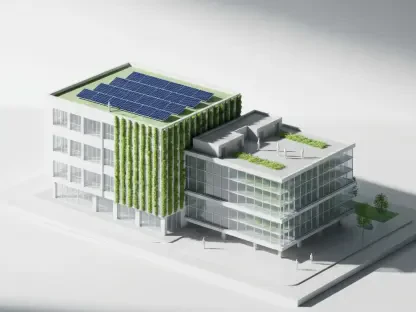The air duct sensor market is currently poised for substantial growth, fueled by advances in technology, the need for energy efficiency, and the proliferation of smart building concepts. Recent projections suggest that the market will reach USD 2.5 billion by 2032, surging from USD 1.59 billion over the seven-year span starting in 2025, with a notable compound annual growth rate of 5.81%. With a current market valuation of USD 1.5 billion, these figures underscore the burgeoning importance of air duct sensors in the heating, ventilation, and air conditioning (HVAC) sector. As the emphasis on optimizing energy consumption intensifies worldwide, the demand for innovative sensor solutions is increasing. These sensors not only play a vital role in ensuring energy efficiency but also enhance indoor air quality and aid the smart integration of building infrastructure.
Driven by Energy Efficiency and Smart Building Integration
Energy-efficient solutions are increasingly sought after in both residential and commercial building settings. Buildings are recognized as significant consumers of energy, prompting both governmental intervention and private sector initiatives to reduce energy consumption. Air duct sensors, which regulate HVAC systems to maintain optimal airflow, are gaining traction as essential instruments in achieving these energy-saving objectives. The momentum towards smart building integration is also transforming the landscape, with the proliferation of Internet of Things (IoT) technologies refining building management standards. Smart infrastructure integration via air duct sensors offers property managers real-time monitoring capabilities, enhancing both comfort and efficiency. Consequently, the modern building environment is becoming increasingly responsive, adapting to human requirements more effectively.
Indoor air quality (IAQ) has become a focal point, particularly in the aftermath of global health crises such as the COVID-19 pandemic. There is heightened awareness about the significance of indoor air quality for health, driving demand for sensors that monitor aspects like temperature, humidity, and air particulates. These sensors are now critical components in maintaining safe and healthy climates within buildings, spurring a global shift towards prioritizing occupant well-being. Recent technological advancements are augmenting this trend, with modern sensors becoming more compact, precise, and capable of digital communication. Innovations such as wireless connectivity, artificial intelligence analytics, and self-calibrating features have expanded the scope and appeal of these devices, encouraging further market adoption.
Regulatory Push and Market Opportunities
Regulatory measures from governments across Europe, North America, and parts of the Asia Pacific are significantly shaping the demand for advanced air duct sensors. These regulations demand stringent energy codes and improved air quality standards, catalyzing the adoption of advanced sensor technologies. The push for compliance with new standards is encouraging both new construction projects and the retrofitting of existing structures. For stakeholders, this regulatory environment presents significant opportunities. The growth of smart cities and intelligent building ecosystems offers fertile ground for the integration of advanced air duct sensors, notably for optimizing HVAC efficiency and facilitating predictive maintenance. Government incentives for green certifications and energy-efficient improvements further boost the adoption of these technologies across residential and commercial properties.
Despite advancements, the market encounters challenges that stakeholders must address. The initial costs and complexities of integrating advanced sensor technologies into legacy systems can create barriers. However, the potential for long-term benefits such as reduced energy consumption, enhanced air quality, and improved operational efficiency presents a compelling case for investment. Some adopters may find that these advantages mitigate the concerns related to upfront costs and integration challenges. As key players navigate these hurdles, strategic foresight and adaptability will be essential for leveraging the market’s full potential. Companies like Schneider Electric, Siemens, Honeywell International, and Johnson Controls are leading the charge, developing IoT and AI-integrated solutions and driving competition in this evolving landscape.
Regional Dynamics and Emerging Trends
From a geographic perspective, regional dynamics are shaping the market’s development. North America is experiencing robust adoption driven by a focus on smart buildings and stringent environmental regulations. Europe maintains its emphasis on energy efficiency and sustainability targets, while the Asia Pacific region is characterized by rapid urbanization and substantial infrastructure investments, marking it as a key growth area. Meanwhile, South America and the Middle East & Africa are contributing to market expansion, spurred by burgeoning construction industries and energy concerns. Emerging trends such as wireless and cloud-based monitoring are indicative of a shift toward sensors that offer remote access and cloud integration, facilitating predictive analytics.
Miniaturization and multifunctionality in sensor design are becoming increasingly prevalent, making these devices more compatible with modern HVAC systems. Furthermore, the integration of artificial intelligence and machine learning in sensor technology introduces a competitive edge, enabling data-driven HVAC control and fault prediction. These advancements enhance the overall market proposition, offering new opportunities for innovation and market penetration. As industry players continue to adapt and innovate, these trends are expected to further shape the trajectory of the air duct sensor market in the coming years.
Strategic Outlook and Future Considerations
As energy efficiency becomes a priority in residential and commercial buildings, efforts to reduce energy consumption are ramping up. Buildings, being major energy users, are seeing both government policies and private initiatives pushing for decreased energy use. Air duct sensors, fundamental to regulating HVAC systems, are pivotal in these energy-saving measures. Additionally, the movement toward smart building technology is reshaping management practices. Through the help of the Internet of Things (IoT), smart infrastructures equipped with air duct sensors allow for real-time monitoring, boosting both comfort and efficiency in building environments, which are now more attuned to human needs.
Attention to indoor air quality (IAQ) has surged, especially following the COVID-19 pandemic, highlighting the importance of healthy indoor environments. This has driven a demand for sensors monitoring temperature, humidity, and air particulates, essential for maintaining safe building climates. Technological advances have led to more compact, precise sensors featuring wireless connectivity, AI analytics, and self-calibration. These innovations have broadened their market appeal and increased adoption, prioritizing occupant well-being.









